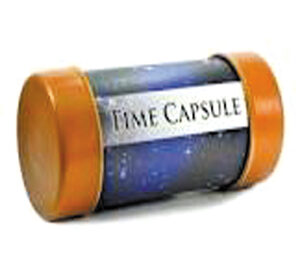 By Henry J. Pratt
By Henry J. Pratt Is burying our artifacts in time capsules just a game, or is it a primitive urge to squirrel away a piece of our lives for future generations?
If one includes the practice of lodging odds and ends in the cornerstone of buildings, then the origin of time capsules goes back to at least ancient Babylon.
Paul Hudson, a co-founder of the International Time Capsule Society (ITCS) in Atlanta, Georgia, thinks we all have a desire to save something for the future. “It’s very human,”” he says. “Our lifetimes are so short.” “Burying time capsules,” Hudson maintains, “is a way that someone a hundred or more years from now can see remnants of our lives. It’s that urge for immortality.”
To Hudson and others who founded the ITCS in 1990, time capsules are serious business. That’s why the ITCS was organized—to maintain a registry of all known time capsules, and to serve as a clearinghouse of information about them.
Stashing away contemporary artifacts in a time capsule to be discovered in future generations is surprisingly popular. There have been some very impressive efforts in the U.S. and elsewhere at preserving the past since the idea first became trendy in the 1930s.
ITCS headquarters is located at Oglethorpe University in Atlanta because the campus is home to what might be called the mother lode of all time capsules—the Crypt of Civilization. Vast in design, the Crypt ushered in the golden age of time capsules during America’s big Depression almost a century ago.
Dr. Thornwell Jacobs, then Oglethorpe’s President, first proposed the idea in the November 1936 issue of the Scientific American magazine.
He issued a challenge “to make available to some civilization now unthought of, and still far in the future, the running story of the life manners and customs of the present civilization.”
Jacobs’ idea was to construct a kind of latter-day pharaoh’s tomb filled with popular cultural artifacts of the 1930s, such as Artie Shaw recordings, artifical fingernails, cuff links, paperclips and a Lionel model train.
Not only such items were buried in the Crypt, but also the knowledge of the last 6,000 years, including microfilm of the Bible, Dante’s Inferno, and motion pictures of more than 3,000 objects, along with the English words identifying them.
Hundreds of interested Americans, including industrialists and philanthropists, helped carry out Jacobs’ ambitious plan. The door to the Crypt of Civilization was dedicated on May 28, 1938 by David Sarnoff, then President of Radio Corporation of America (RCA), and officially sealed two years later, on May 25, 1940.
One of the most amazing facts about the Crypt is the length of time Jacobs intends for it to be sealed—6,177 years. It’s scheduled to be opened at noon, May 28, 8113, chosen because it was as far in the future from 1936 as the first recorded date in history was in the past—4,241 B.C.
Another visionary time-capsule project was planned and designed about the same time as the Crypt, by G. Edward Pendray for the Westinghouse Electric Corp. Pendray used a cylindrical storage device, which he called a “time bomb” because of its shape.
But by 1938, he coined a new term: “time capsule.” The new name fired up the public’s interest and imagination in such save-our-civilization endeavors. Time-capsule projects were soon being created and completed with a passionate fury that remains so today with little letup. But are time capsules a boon or a boondoggle?
The Westinghouse Time Capsule is filled with 35 “small articles of common use,” textile and plastic samples, and microfilm records of 100 books. Included also is a copy of The Book of Record, which details the container’s contents and has messages to future generations from Albert Einstein and Thomas Mann.
The torpedo-shaped capsule was buried below the Westinghouse pavilion during the 1939 New York World’s Fair. It is to be opened 5,000 years after it is sealed, in 6939.
Then, during the 1964-65 New York’s World’s Fair, Westinghouse buried a second capsule 10 feet away from the first. Its contents—including a Beatles record and a bikini bathing suit—reflect the enormous changes in U.S. society in the quarter century between burial of the two capsules. Replicas of the capsules and their contents can be seen at the George Westinghouse Museum, just outside Pittsburgh, Pennsylvania.
The modern time capsule is largely an American phenomenon, but the United States isn’t the only nation pursuing large-scale time-capsule projects.
Two identical kettle-shaped vessels were buried in 1970 in Osaka, Japan. One of the capsules is to remain sealed for 5,000 years. The second was opened for the first time in 2000 to check the contents, then once every century after that until both are finally opened in 6970.
What is in the two Osaka capsules? They hold 12,098 items—including picture scrolls and stainless-steel etchings, along with a typical Japanese businessman’s calendar, complete with handwritten scrawls and appointment notations.
The issue as to whether time capsules are a boon or a boondoggle remains undecided as we continue the 21st century. One might conclude, with considerable veracity—only time will tell.















Follow Us